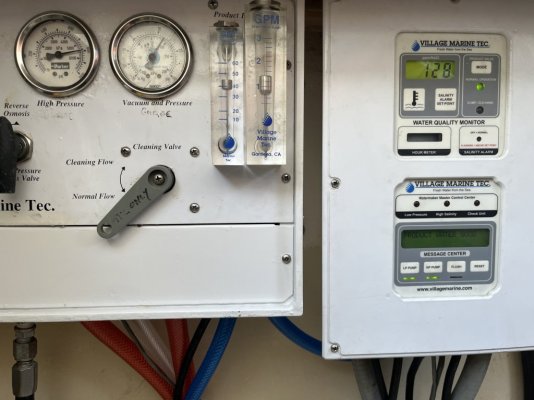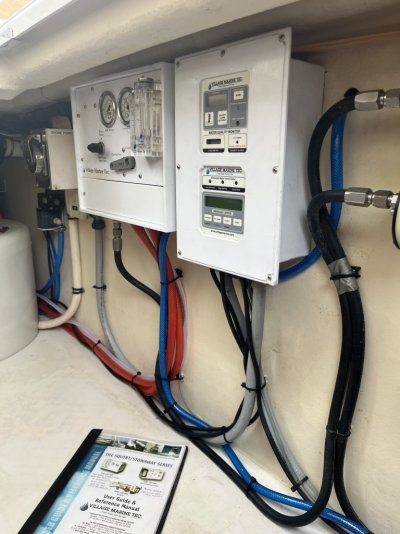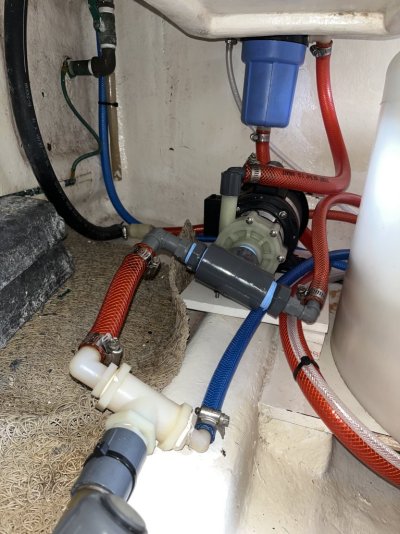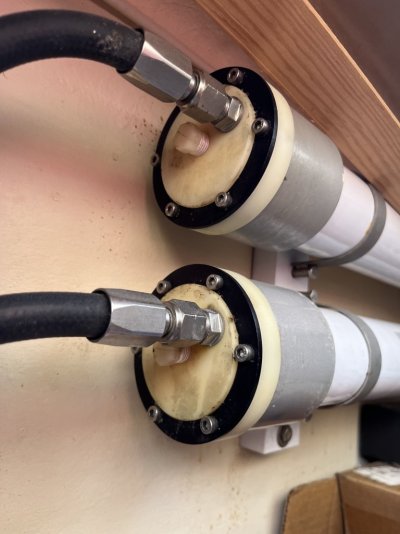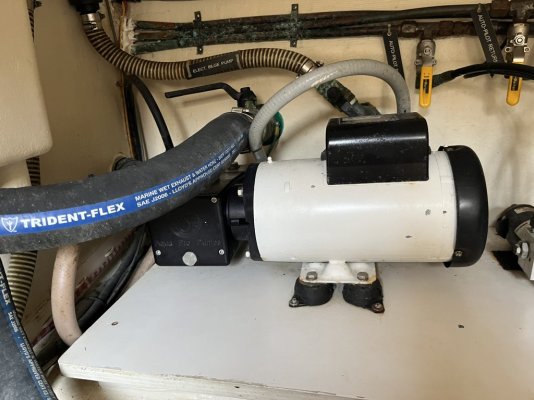kernr
Senior Member
- Joined
- May 29, 2020
- Messages
- 164
- Location
- United States
- Vessel Name
- Serenity
- Vessel Make
- Grand Banks 47 Europa
Good Afternoon all -
I have owned "Serenity" now for 4 1/2 years and finally getting ready for more distant cruising. To do so I've decided to finally get the water maker working. So, I turned it on in June for the second time since owning the boat - the other time was the fall of 2020 to pickle the system with antifreeze. Watching the sea water strainer upon turning the Low Pressure Pump on was interesting in that I heard a hum but flow was non - existent. Basically the LP Pump wasn't running. This is a modular Village Marine (Parker) MPW 800 and the only recommended replacement pump is made by March and is the TE 5C MD (Many $$$$). I took two days to remove old LP Pump due to Cablemaster Shore Power Storage system sitting within 1/4 " of the old pump body - basically the water maker was installed new in 2008 and Cablemaster installed later. At this point while awaiting LP Pump to arrive I replaced every hose in the system. The old hoses were all extremely sticky and dirty on outside - not sure why. Many tubes in Instrument box were leaking - it was a rain forest. Once hoses were installed and the new LP Pump we started the system. It took a couple of starts to get air out of system and HP Pump to stay on but we are now able to make "Good Product". Obviously I spent a considerable amount of time with the tech manual for the system but it has left me wit a few novice questions on water maker system operations. Let me ask the questions and possibly someone on the TF will have great answers:
(1) The system has both a Master Controller and a Remote Controller - it also has an automatic FW flush assembly. When I am looking at the read out display it says above it "ppm Na/Cl". I expected to see "TDS" - do they mean the same thing in this case and good product is <500 ppm? The other read out of the Master states "PRODUCT WATER GOOD"
(2) So far I have operated the system in the midst of the modular units in the boats aft lazarette and not from the Remote Control Center (RCC) at the lower helm. When turning the system on I follow the manual and turn on LP Pump and HP Pump and after a minute making sure there are no leaks and no air bubbles I slowly rotate the Black HP Bypass valve to the Normal / RO position bringing the pressure up to 800 psi. My question is - when operating at lower helm using RCC how does system get the bypass valve from cleaning to RO position? Or if I am going to operate from RCC do I leave the black valve in the RO position at the Master station and then press the LP Pump and HP Pump buttons?
(3) Looking at Product flowmeter it shows right around 45 GPH which seems really high - multiply by 24 hours is over 1000 gallons per day - what am I missing?
A couple of photos attached -
I am sure I will have a bunch more questions as I move forward but Parker is not responding very quickly.
Thanks for any assistance provided,
Bob
I have owned "Serenity" now for 4 1/2 years and finally getting ready for more distant cruising. To do so I've decided to finally get the water maker working. So, I turned it on in June for the second time since owning the boat - the other time was the fall of 2020 to pickle the system with antifreeze. Watching the sea water strainer upon turning the Low Pressure Pump on was interesting in that I heard a hum but flow was non - existent. Basically the LP Pump wasn't running. This is a modular Village Marine (Parker) MPW 800 and the only recommended replacement pump is made by March and is the TE 5C MD (Many $$$$). I took two days to remove old LP Pump due to Cablemaster Shore Power Storage system sitting within 1/4 " of the old pump body - basically the water maker was installed new in 2008 and Cablemaster installed later. At this point while awaiting LP Pump to arrive I replaced every hose in the system. The old hoses were all extremely sticky and dirty on outside - not sure why. Many tubes in Instrument box were leaking - it was a rain forest. Once hoses were installed and the new LP Pump we started the system. It took a couple of starts to get air out of system and HP Pump to stay on but we are now able to make "Good Product". Obviously I spent a considerable amount of time with the tech manual for the system but it has left me wit a few novice questions on water maker system operations. Let me ask the questions and possibly someone on the TF will have great answers:
(1) The system has both a Master Controller and a Remote Controller - it also has an automatic FW flush assembly. When I am looking at the read out display it says above it "ppm Na/Cl". I expected to see "TDS" - do they mean the same thing in this case and good product is <500 ppm? The other read out of the Master states "PRODUCT WATER GOOD"
(2) So far I have operated the system in the midst of the modular units in the boats aft lazarette and not from the Remote Control Center (RCC) at the lower helm. When turning the system on I follow the manual and turn on LP Pump and HP Pump and after a minute making sure there are no leaks and no air bubbles I slowly rotate the Black HP Bypass valve to the Normal / RO position bringing the pressure up to 800 psi. My question is - when operating at lower helm using RCC how does system get the bypass valve from cleaning to RO position? Or if I am going to operate from RCC do I leave the black valve in the RO position at the Master station and then press the LP Pump and HP Pump buttons?
(3) Looking at Product flowmeter it shows right around 45 GPH which seems really high - multiply by 24 hours is over 1000 gallons per day - what am I missing?
A couple of photos attached -
I am sure I will have a bunch more questions as I move forward but Parker is not responding very quickly.
Thanks for any assistance provided,
Bob

